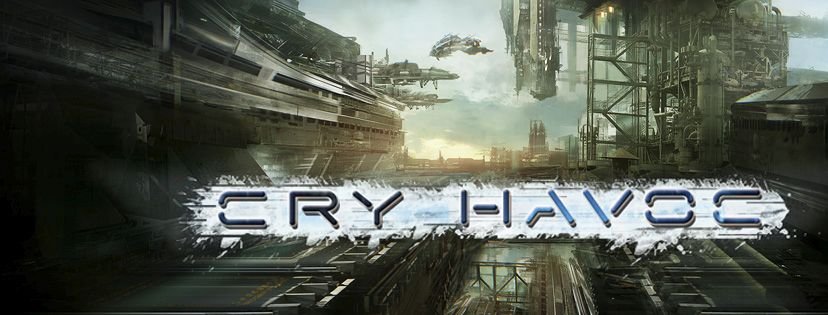
This is part 4 in a series of strategy articles brought to you by the game’s original designer, Grant Rodiek.
Welcome to the strategy guide for the Human faction of Cry Havoc. The Humans are the boogeymen of Cry Havoc, the invincible and overwhelming space marines with their cursed use of Drop Trooper cards and Airfields. This menace, while obvious and hard hitting like a well-wielded hammer, is not invincible. In some ways this guide may evolve less towards how to win with them, and more towards how to defeat them.
I jest, because I’m a smart alek and cannot help it, but don’t lose heart when contesting the Humans. Cry Havoc is an asymmetric game, and all of the factions are rated on a curve of difficulty. The Humans are the most obvious and the most simple. If Cry Havoc were not asymmetric, every player would probably control the Humans. They are the best faction to give to your new friend, or a player who is less adept at planning ahead, less skilled at recovering from mistakes, or just likes to Hulk smash.
Let’s dig into these Human scoundrels, shall we?
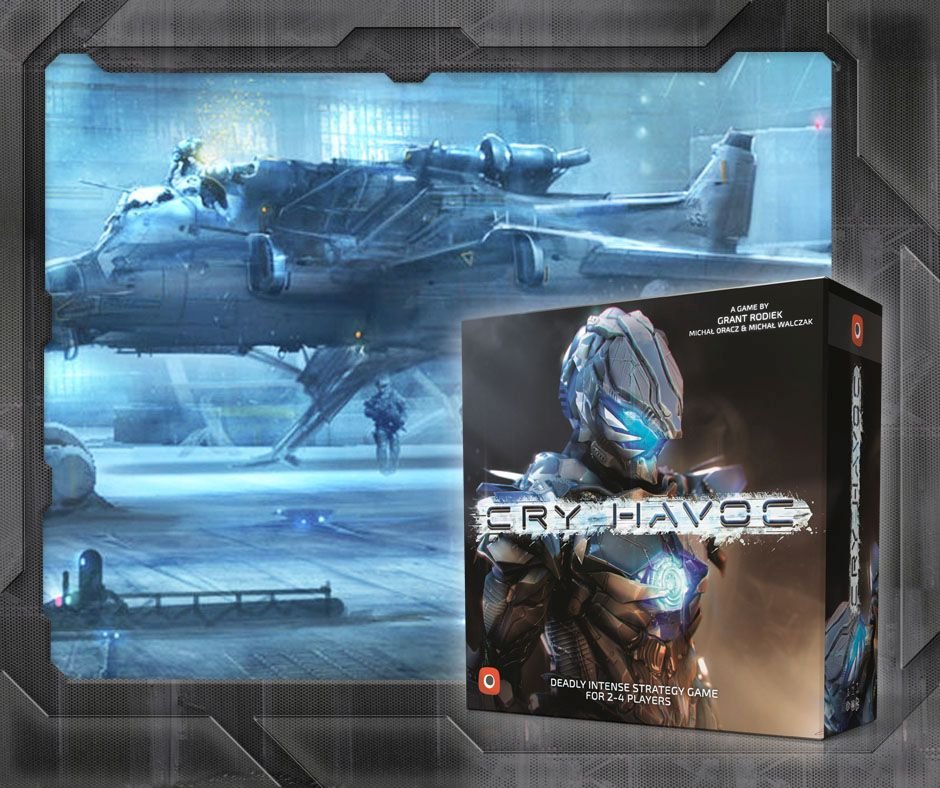
The Original Inspiration
The Humans were originally inspired by highly mobile cavalry units, or the armored tactics of the Germans during World War II. Back when Cry Havoc was Battle for York, before Skills, every faction had a passive “support” ability. For the Humans, then known as the Royal Brigade, they could effectively move an additional time if they were moving into a Battle. This meant if you saw a pocket of Royal Brigade cubes on the map, you knew they had a two space punch radius.
Effectively, they were the boxers with the long reach.
Now that all four guides are out, just to reflect on all of them, the original inspirations were:
Machines: Defensive, disciplined troops.
Humans: Highly mobile and aggressive.
Pilgrims: Tricky, nefarious, less battle focused.
Trogs: Hit and run guerilla tactics.
I’d say that’s still mostly true! Fun to look back on the history. Let’s step briefly into the present.
We’re dropping in 8 seconds, ooh rah!
I love space marines. I love love love them. In Halo, whenever the ODST (Orbital Drop Shock Troopers) showed up, I was plain happier. When Starship Troopers hit the big screen, I was thrilled. When I discovered it was based on a book, I was even happier. The armored marines in The Expanse series? Awesome. I love Bobbie Draper. Sardaukar pouring out of drop ships? Yes please.
Cry Havoc’s theme is a love letter to gritty, war-focused science fiction. There can be an urge sometimes to create something entirely novel or new, but a good theme often roots people into the experience and basically says: this is where you are. People who have read these books, played Starcraft, seen the movies, can sorta get the gist when they sit down to Cry Havoc. I know this, because I can see things click when I make these comparisons at demos.
Maybe in the future we’ll venture farther off the beaten path, but we wanted to ground ourselves first into the classics, and our human drop troopers are the very center piece of that desire.

The Strengths of the Humans
The Humans are lightning fast in the game. It is their goal to win the game early, then hold on as the Pilgrims and Machines begin to turn their engines to a fine, purring fury. Every Skill and Structure in the Human arsenal is devoted to this blitzkrieg style of warfare, and very few are devoted to them actually keeping their territory.
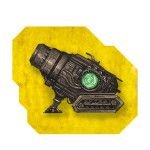 In the beginning of the game for most, players will want to Recruit to maximize their initial move, or Move with their starting Units in force to a Region with a discovery token and another with some Trogs. Using Scouting, the Humans can take control of an adjacent Region, then Build Artillery as their first Action. They can then activate the Artillery to put an Artillery token into a Region with Trogs. If you have the Units to solve that Attrition issue, a Watchtower token will firm up your approach towards the Territory Control. If you have the Wrenches? Do both!
In the beginning of the game for most, players will want to Recruit to maximize their initial move, or Move with their starting Units in force to a Region with a discovery token and another with some Trogs. Using Scouting, the Humans can take control of an adjacent Region, then Build Artillery as their first Action. They can then activate the Artillery to put an Artillery token into a Region with Trogs. If you have the Units to solve that Attrition issue, a Watchtower token will firm up your approach towards the Territory Control. If you have the Wrenches? Do both!
 Artillery is incredibly useful and potent in that it acts as two Attrition that cannot be prevented or altered. But, it cannot be placed in Battle Regions. Neither can a Watchtower! This means Humans need to activate it before their move, which alerts the enemy that they are coming. Now, a savvy Human player knows this, and they can place it simply as a bluff, or a deterrent. If I know you’re going to kill two of my Units, I may go elsewhere, or wait longer until I can bulk up my attacking force.
Artillery is incredibly useful and potent in that it acts as two Attrition that cannot be prevented or altered. But, it cannot be placed in Battle Regions. Neither can a Watchtower! This means Humans need to activate it before their move, which alerts the enemy that they are coming. Now, a savvy Human player knows this, and they can place it simply as a bluff, or a deterrent. If I know you’re going to kill two of my Units, I may go elsewhere, or wait longer until I can bulk up my attacking force.
Knowing that Artillery and Watchtower cannot be placed in Battle Regions is a very good incentive to be the first mover. If you have the correct Tactics, such as ones that let you add Units, you can move in with a weaker force, prevent Humans from turning on their Structures, and then bulk up in the battle itself. Humans really like to go sooner in initiative for this very reason, and knowing that is very much to your advantage.
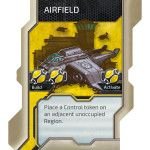 Airfield is also useful, though a Human player will need to stock up on Wrenches (i.e. Mountain Tactics cards) to activate it AND Artillery. Airfield also has limited use, as eventually the Human will either have all of the surrounding Regions, or they’ll no longer be unoccupied. Humans need to capitalize on its benefits sooner rather than later.
Airfield is also useful, though a Human player will need to stock up on Wrenches (i.e. Mountain Tactics cards) to activate it AND Artillery. Airfield also has limited use, as eventually the Human will either have all of the surrounding Regions, or they’ll no longer be unoccupied. Humans need to capitalize on its benefits sooner rather than later.
Why is that? Well, the Human default Skill is Occupation. Humans can discard a card to use it each round. Occupation grants Humans 1 Point for every Region they Control. If the Humans do this every round for even just 3 Regions per round, that’s 15 points! But, keep a few things in mind. The Humans must discard a card, which means they cannot use it to Build, Activate, Move, or Battle. Card advantage, like in Magic, is a real thing.
 While we’re on the topic of Occupation, and Airfields, we must also talk about Enable Scoring. This is a very costly and contextual Action and it’s one the Humans very much want to have. If a Human has even 3 Regions and in the same round they use Occupation, and Enable Scoring, that’s 6 points. But, don’t be disheartened. In the same way Occupation consumes cards and Actions, Enable Scoring does the same. The Humans are strong out the gate, and weak in the marathon. Time they spend doing this means they will win fewer fights, and their deck will be less potent. If you can steal Enable Scoring from them, or diminish its benefits, by the fourth and fifth round the Humans will be like a bunch of weekend warriors facing off against Special Forces.
While we’re on the topic of Occupation, and Airfields, we must also talk about Enable Scoring. This is a very costly and contextual Action and it’s one the Humans very much want to have. If a Human has even 3 Regions and in the same round they use Occupation, and Enable Scoring, that’s 6 points. But, don’t be disheartened. In the same way Occupation consumes cards and Actions, Enable Scoring does the same. The Humans are strong out the gate, and weak in the marathon. Time they spend doing this means they will win fewer fights, and their deck will be less potent. If you can steal Enable Scoring from them, or diminish its benefits, by the fourth and fifth round the Humans will be like a bunch of weekend warriors facing off against Special Forces.
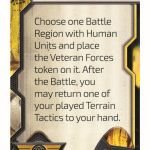 “Eesh!” think the Humans. We have to get better cards! Veteran Forces gives one card a double use. If you’re smart and pick your battles in consistent Terrain, that’ll help recoup that loss in Actions. Recon Forces rewards that early aggression even more by granting you a free Tactics draw for every Battle in which you’re the attacker. If Recon Forces is a skill in the game, your first Action every round should be Artillery, followed by a massive Move into as many Territories as possible! Similar to Data Extraction for the Pilgrims, a Human player with Recon Forces should be as aggressive as they can afford to be.
“Eesh!” think the Humans. We have to get better cards! Veteran Forces gives one card a double use. If you’re smart and pick your battles in consistent Terrain, that’ll help recoup that loss in Actions. Recon Forces rewards that early aggression even more by granting you a free Tactics draw for every Battle in which you’re the attacker. If Recon Forces is a skill in the game, your first Action every round should be Artillery, followed by a massive Move into as many Territories as possible! Similar to Data Extraction for the Pilgrims, a Human player with Recon Forces should be as aggressive as they can afford to be.
Seek and Destroy is the final Human Skill and the crown jewel of schadenfreude fiends and spoil sports everywhere. As it’ll resolve last it may not be the best point generator, but it can guarantee a position is sufficiently soft for a future round’s conquest. The Machines should be constantly evening the scales with their Shred Drones and Orbital Snipers to make it simple for them to move in next round. Seek and Destroy is a more focused and lower cost option for the Humans. Don’t chase a few measly VP with Seek and Destroy. Use it to guarantee and easier conquest of a Crystal rich adjacent Region. Soften it further next round with Watchtower and Artillery, and go for that late game 8 point swing. Eyes on the prize, Marine.
Whereas the Machines and Pilgrims are slowly, steadily marching towards a single goal the entire game, a good Human player needs to pivot. Early in the game, they are trying to snatch easier territory, seeking bloodless victories, to build a small, but steadily growing buffer of victory points using Occupation and Enable Scoring. Around mid-game, they need to quiet themselves for a bit, step out of the limelight, and refine their deck. In the final rounds, they need to choose where to stand firm against big Machine and Pilgrim pushes. When the Regions are worth 5-8 points in that last round, holding one or two of them is the difference between Human hegemony and an efficient Machine meat farm. Or, Pilgrim science, but I didn’t have a clever name for them.
The Weaknesses of the Humans
The Humans are not very good at holding onto what they take. Not being able to use Artillery and Watchtower in a Battle Region means humans forfeit initiative in every round to those who are more willing to punch them. In 3-4 player games, non-Human players must pay a slight tax which is devoting some effort to curtailing early Human (and Trog) expansionism. Not your entire round, but an Action here or there to keep the Humans in check.
In two player? You need to fundamentally alter your strategy. The Humans are good at dancing around the boxing ring and can bat away unfocused thrusts. If you come at them, head on, with one focus in mind? They’ll crumble like wet paper. A few weeks ago I managed to constrain my friend on a single front, and the sheer onslaught of my focus was too much for him. If the humans are getting rowdy? Go for the nose. They multi-task really well, but they suffer when you go head first.
Humans also lose steam long term. They spend Actions and cards to score points, which they should do, but it means that if they don’t shore up their card disadvantage at some point, or catch a windfall through discoveries, they’ll simply be ill-equipped for the late game carnage.
Human Structures also lose steam. Artillery and Watchtower and Airfield are great, but they have a short leash and as the front lines move and evolve, the Human buildings become outdated and ineffectual. Machines have Moving City and Transform, and Pilgrims don’t really want to move, and Trogs are literally everywhere, but Humans? They’re stuck. Knowing this, you can refuse to feed them. Every battle adds more crystals. What the humans want more than anything is for you to keep fighting on their doorstep. Even if they lose some of them, as long as they end up with that juicy, valuable region in the end? They’ll win. Let the Humans have their puny 1-3 Crystal Regions. Go for it. Have it. We’ll fight to the death over the good stuff over here, outside the range of your Artillery.
Human Strategy Tips
- Humans need to build a VP buffer early by exploiting Occupation, Scouting, Airfield, and Enable Scoring.
- Humans need to think ahead to the next round so they can use Artillery and Watchtower to support their assaults. Once it’s a battle region, these are useless.
- Humans need to pivot at some point to strengthen their Tactics, or else the final two rounds will be very difficult as the Humans will find themselves outmatched.
- Humans should try to keep their opponents unfocused and distracted. Humans profit most when their enemies must deal with multiple fronts. Focused Machines and Trogs are way, way more scary.
 Polski
Polski English
English Deutsch
Deutsch



